Implementation of the Displacement Discontinuity Method in Geotechnical Case Studies
Abstract
1. Introduction
- The effect of joints in a compressive field on the stability of a circular opening as a function of the friction angle and joint inclination;
- The effect of the normal and shear stiffness modulus on the stress distribution on the joint surfaces;
- Crack propagation in the case of the hydraulic fracture technique, introducing internal pressure to simulate pressurized fluids.
2. The Displacement Discontinuity Method
- The solution is found by solving smaller linear equation systems than using finite element/finite difference methods, but the matrixes are dense (without zeroes), requiring the highest computational effort for obtaining a solution.
- It is hard to apply in a non-linear medium.
- The stress field is very large near the tip of each element, so appropriate discretization should be chosen to avoid instabilities in the solution.
- Additionally, for DDM, tangential stresses require corrections using a finite difference scheme.
3. Displacement Discontinuity Solutions
3.1. Contact Element Solutions
- For the excavation elements (,
- For two stabilization elements (Figure 4) (,
- For the crack elements in the non-slip case (,
- Finally, for sliding elements, the above system is modified (:
3.2. Solutions of an Inclined Crack in a Compressive Field
3.3. Solution with Internal Pressure (Hydraulic Fracturing)
4. Discussion and Conclusions
- (a)
- In this paper, the effect of the joint interface’s friction angle was investigated on the stability of underground excavations, where the slip occurs for friction angles, , that are less than the joint angle, . When no slip occurs, the shear and normal stiffness, Ks and Kn, of the interface elements play an essential role, and using very high values with respect to stiffness deactivates the existence of the crack. In addition to the sliding of the joint, as demonstrated by Dyskin’s experiments [35], the joint can also propagate in the case of a compressive stress field. The DDM method is a helpful tool for a fast and accurate assessment of the stability of underground excavations provided that the location and orientation of joints need to be determined. A useful monitoring technique for identifying a crucial rock mass defect (joint) that could impact the functionality of underground excavations is presented in the work of Radosław et al. [11].
- (b)
- The second problem considered here was the effect of internal pressure on the circular opening that simulates hydraulic fracturing, a method that finds applications in hydrocarbon exploitation and wellbore stability. The problem’s complete solution is a multi-factor problem as fluids coexist and alter the behaviour of the medium, and they have been studied by many scientists [19,20,21,22,23]. This paper presents an approach with two limit cases: i) No pressure is transferred at all in the fracture, producing the smallest SIFs, and ii) all pressure is transferred to the fracture’s tip, producing the largest SIFs. The actual SIF values will vary between these two solutions. Also, the accurate estimations of SIFs were proven by carrying out a comparison with the existing mode I solution in the SIF handbook [27], and they were provided by Equation (16). The relative error was found to be less than 4% in the examined case.
Author Contributions
Funding
Data Availability Statement
Conflicts of Interest
References
- Crouch, S.L. Analysis of Stresses and Displacements Around Underground Excavations: An Application of the Displacement Discontinuity Method; Second printing; Geomechanics report; University of Minnesota: Minneapolis, MN, USA, 1980; Volume 268. [Google Scholar]
- Crouch, S.; Starfield, A.M. Boundary Element Methods in Solid Mechanics; Unwin Hyman: Boston, MA, USA, 1990. [Google Scholar]
- Yan, X. Multiple Crack Fatigue Growth Modeling by Displacement Discontinuity Method with Crack-Tip Elements. Appl. Math Model 2006, 30, 489–508. [Google Scholar] [CrossRef]
- Yan, X. An Efficient and Accurate Numerical Method of Stress Intensity Factors Calculation of a Branched Crack. J. Appl. Mech. Trans. ASME 2005, 72, 330–340. [Google Scholar] [CrossRef]
- Exadaktylos, G.; Xiroudakis, G. The G2 Constant Displacement Discontinuity Method-Part I: Solution of Plane Crack Problems. Int. J. Solids Struct. 2010, 47, 2568–2577. [Google Scholar] [CrossRef][Green Version]
- Exadaktylos, G.; Xiroudakis, G. A G2 Constant Displacement Discontinuity Element for Analysis of Crack Problems. Comput. Mech. 2010, 45, 245–261. [Google Scholar] [CrossRef]
- Exadaktylos, G.; Xiroudakis, G.; Stavropoulou, M. Three-Dimensional Elastic Analysis of Rock Excavations by Using the G2 Constant Displacement Discontinuity Method. Procedia Eng. 2017, 191, 1087–1095. [Google Scholar] [CrossRef]
- Shen, B.; Shi, J.; Rinne, M.; Siren, T.; Suikkanen, J.; Kwon, S.; Min, K.B. Two-Dimensional Displacement Discontinuity Method for Transversely Isotropic Materials. Int. J. Rock Mech. Min. Sci. 2016, 83, 218–230. [Google Scholar] [CrossRef]
- Shou, K.J.; Napier, J.A.L. A Two-Dimensional Linear Variation Displacement Discontinuity Method for Three-Layered Elastic Media. Int. J. Rock Mech. Min. Sci. 1999, 36, 719–729. [Google Scholar] [CrossRef]
- Duenser, C.; Beer, G. Simulation of Sequential Excavation with the Boundary Element Method. Comput. Geotech. 2012, 44, 157–166. [Google Scholar] [CrossRef]
- Radosław, W.; Waldemar, K.; Łukasz, B.; Waldemar, R. Identification of Rock Mass Critical Discontinuities While Borehole Drilling. Energies 2021, 14, 2748. [Google Scholar] [CrossRef]
- Lin, Q.; Cao, P.; Meng, J.; Cao, R.; Zhao, Z. Strength and Failure Characteristics of Jointed Rock Mass with Double Circular Holes under Uniaxial Compression: Insights from Discrete Element Method Modelling. Theor. Appl. Fract. Mech. 2020, 109, 102692. [Google Scholar] [CrossRef]
- Lisjak, A.; Mahabadi, O.K.; Kaifosh, P.; Vietor, T.; Grasselli, G. A Preliminary Evaluation of an Enhanced FDEM Code as a Tool to Simulate Hydraulic Fracturing in Jointed Rock Masses. In Proceedings of the Rock Engineering and Rock Mechanics: Structures in and on Rock Masses-Proceedings of EUROCK 2014, ISRM European Regional Symposium, Vigo, Spain, 26–28 May 2014. [Google Scholar]
- Liu, B.; Lin, H.; Chen, Y.; Liu, J.; Guo, C. Deformation Stability Response of Adjacent Subway Tunnels Considering Excavation and Support of Foundation Pit. Lithosphere 2022, 2022, 7227330. [Google Scholar] [CrossRef]
- Exadaktylos, G.E.; Liolios, P.A.; Stavropoulou, M.C. A Semi-Analytical Elastic Stress-Displacement Solution for Notched Circular Openings in Rocks. Int. J. Solids Struct. 2003, 40, 1165–1187. [Google Scholar] [CrossRef]
- Dac, T.N.; My, D.D.T.; Ahmed, A.; Thai, H.P.; Rehman, S.U.; Truong, S.N.; Hong, G.K. Combining Sonic While Drilling and Formation Pressure While Drilling for Pore Pressure Analysis to Reduce Drilling Risk: A Case Study in Offshore Vietnam. In Proceedings of the Offshore Technology Conference Asia, Kuala Lumpur, Malaysia, 22–25 March 2016. [Google Scholar]
- Chen, E.; Leung, C.K.Y.; Tang, S.; Lu, C. Displacement Discontinuity Method for Cohesive Crack Propagation. Eng. Fract. Mech. 2018, 190, 319–330. [Google Scholar] [CrossRef]
- Wu, H.; Zhao, G.; Liang, W. Investigation of Cracking Behavior and Mechanism of Sandstone Specimens with a Hole under Compression. Int. J. Mech. Sci. 2019, 163, 105084. [Google Scholar] [CrossRef]
- Manouchehrian, A.; Kulatilake, P.H.S.W. Numerical Study on Rock Failure around a Tunnel Destressed by a Conceptualized Notched Technique. Undergr. Space 2022, 7, 1086–1097. [Google Scholar] [CrossRef]
- Haeri, H.; Sarfarazi, V.; Hedayat, A.; Zhu, Z. Numerical Simulation of Hydraulic Fracturing in Circular Holes. Comput. Concr. 2016, 18, 1135–1151. [Google Scholar] [CrossRef]
- Tang, S.; Dong, Z.; Duan, D.; Li, Y. A Theoretical Model for Hydraulic Fracturing through Two Symmetric Radial Perforations Emanating from a Borehole. Adv. Mater. Sci. Eng. 2019, 2019, 6094305. [Google Scholar] [CrossRef]
- Wang, S.; Yu, X.; Winterfeld, P.H.; Wu, Y.S. Real-Time Simulation of Hydraulic Fracturing Using a Combined Integrated Finite Difference and Discontinuous Displacement Method: Numerical Algorithm and Field Applications. Water 2023, 15, 938. [Google Scholar] [CrossRef]
- Azarov, A.; Patutin, A.; Serdyukov, S. Hydraulic Fracture Propagation near the Cavity in a Poroelastic Media. Appl. Sci. 2021, 11, 11004. [Google Scholar] [CrossRef]
- Weber, N.; Siebert, P.; Willbrand, K.; Feinendegen, M.; Clauser, C.; Fries, T.P. The XFEM with an Explicit-Implicit Crack Description for Hydraulic Fracture Problems. In Proceedings of the ISRM International Conference for Effective and Sustainable Hydraulic Fracturing 2013, Brisbane, Australia, 20–22 May 2013. [Google Scholar]
- Sarris, E.; Papanastasiou, P. The Influence of the Cohesive Process Zone in Hydraulic Fracturing Modelling. Int. J. Fract. 2011, 167, 33–45. [Google Scholar] [CrossRef]
- Erdogan, F.; Sih, G.C. On the Crack Extension in Plates under Plane Loading and Transverse Shear. J. Fluids Eng. Trans. ASME 1963, 85, 519–525. [Google Scholar] [CrossRef]
- Tada, H.; Paris, P.C.; Irwin, G.R. The Stress Analysis of Cracks Handbook, 3 rd ed.; ASME Press: New York, NY, USA, 2000. [Google Scholar]
- Dang, H.T.; Berre, I.; Keilegavlen, E. Two-Level Simulation of Injection-Induced Fracture Slip and Wing-Crack Propagation in Poroelastic Media. Int. J. Rock Mech. Min. Sci. 2022, 160, 105248. [Google Scholar] [CrossRef]
- Wang, J.; Peng, G.; Cong, Z.; Hu, B. Hydraulic Fracture Propagation and Proppant Transport Mechanism in Interlayered Reservoir. Energies 2023, 16, 5017. [Google Scholar] [CrossRef]
- Schultz, R.A. Stress Intensity Factors for Curved Cracks Obtained with the Displacement Discontinuity Method. Int. J. Fract. 1988, 37, R31–R34. [Google Scholar] [CrossRef]
- Zhang, J.; Yang, W.; Chen, J.; Xu, R. Direct Evaluation of the Stress Intensity Factors for the Single and Multiple Crack Problems Using the P-Version Finite Element Method and Contour Integral Method. Appl. Sci. 2021, 11, 8111. [Google Scholar] [CrossRef]
- Crawford, A.M.; Curran, J.H. Higher-Order Functional Variation Displacement Discontinuity Elements. Int. J. Rock Mech. Min. Sci. 1982, 19, 143–148. [Google Scholar] [CrossRef]
- Exadaktylos, G. Gradient Elasticity with Surface Energy: Mode-I Crack Problem. Int. J. Solids Struct. 1998, 35, 421–456. [Google Scholar] [CrossRef]
- Exadaktylos, G.; Vardoulakis, I.; Aifantis, E. Cracks in Gradient Elastic Bodies with Surface Energy. Int. J. Fract. 1996, 79, 107–119. [Google Scholar] [CrossRef]
- Dyskin, A.V.; Sahouryeh, E.; Jewell, R.J.; Joer, H.; Ustinov, K.B. Influence of Shape and Locations of Initial 3-D Cracks on Their Growth in Uniaxial Compression. Eng. Fract. Mech. 2003, 70, 2115–2136. [Google Scholar] [CrossRef]
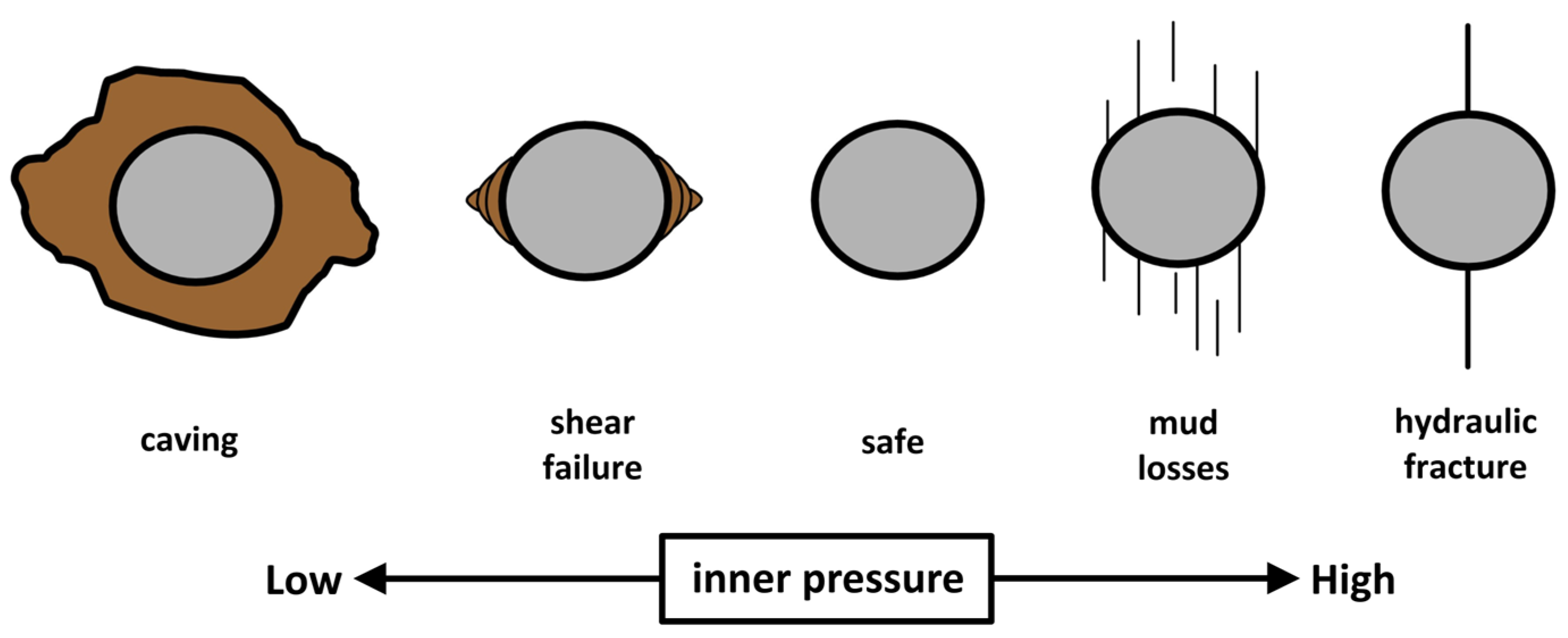

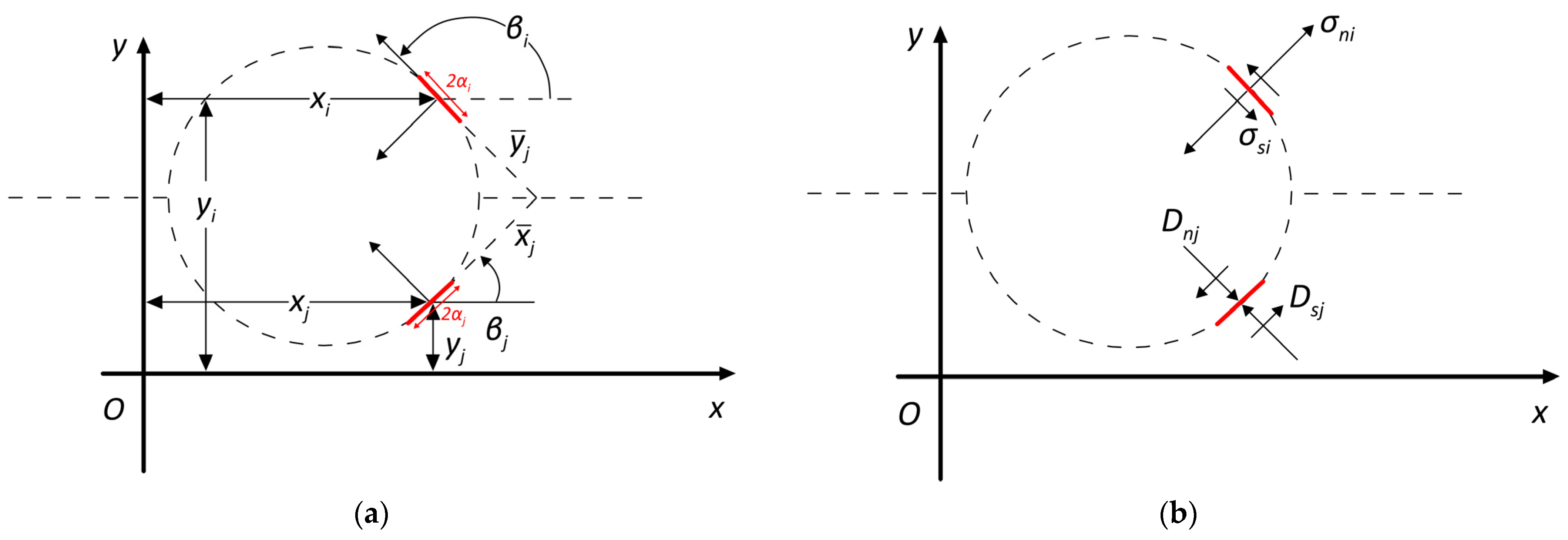
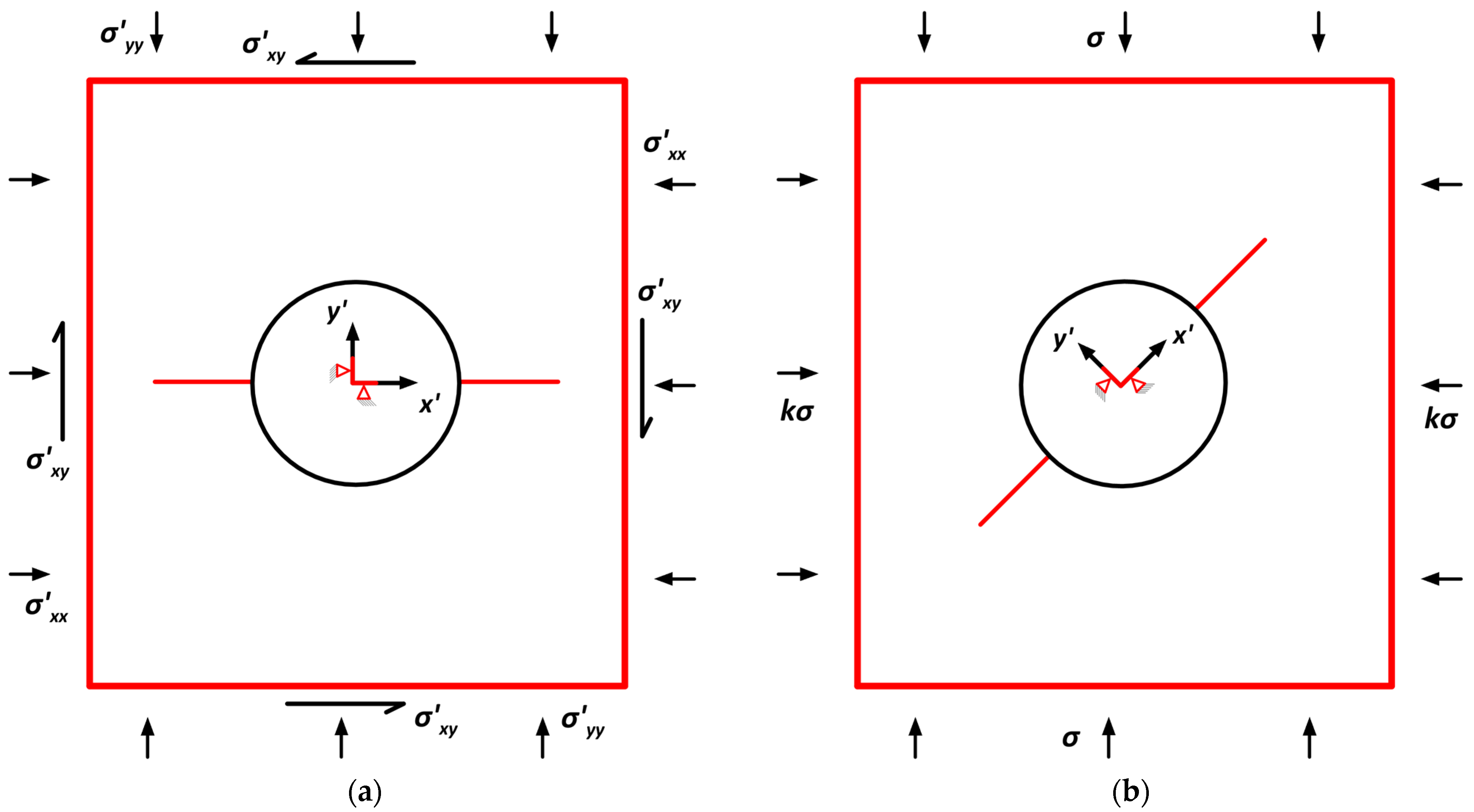


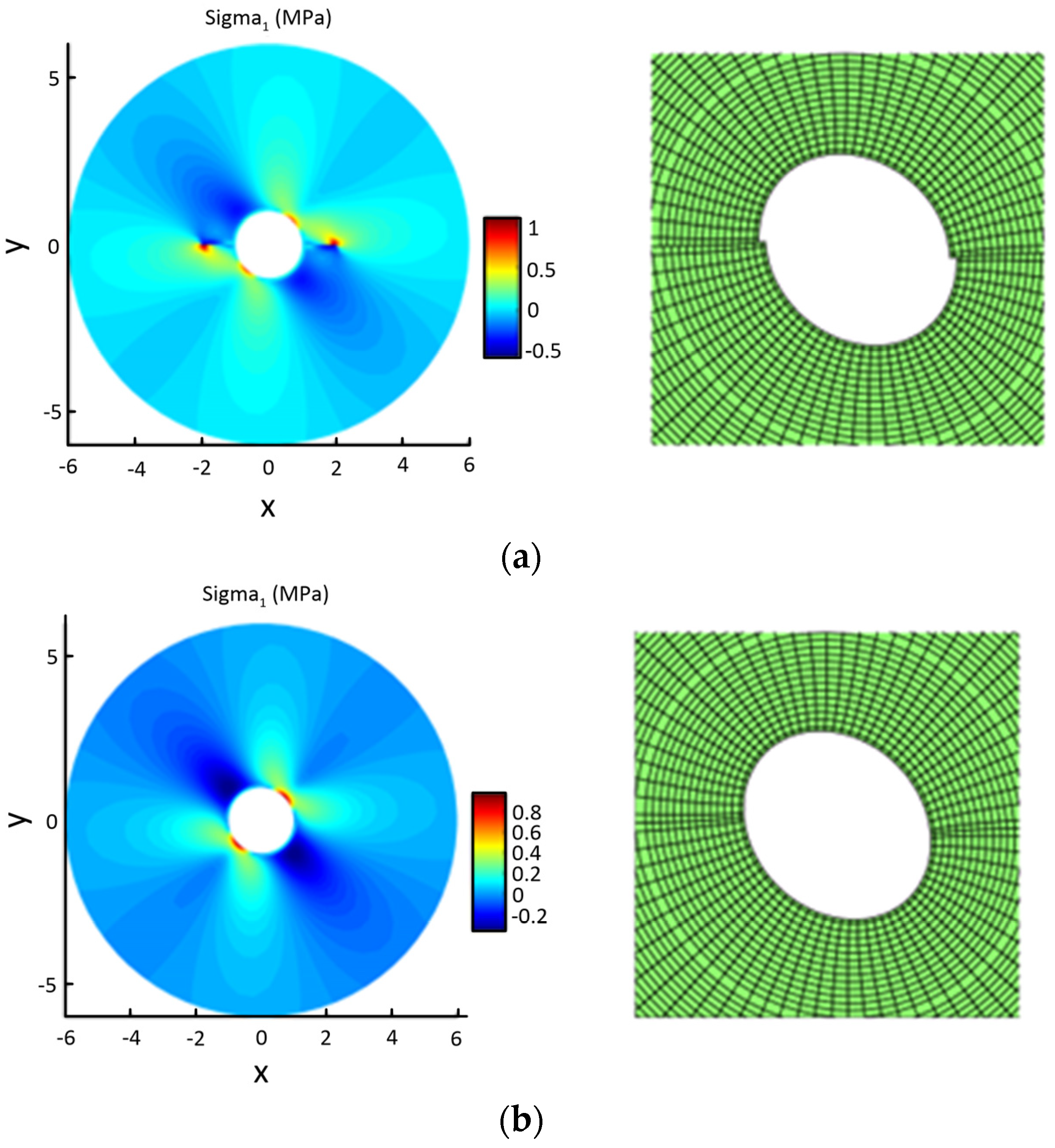

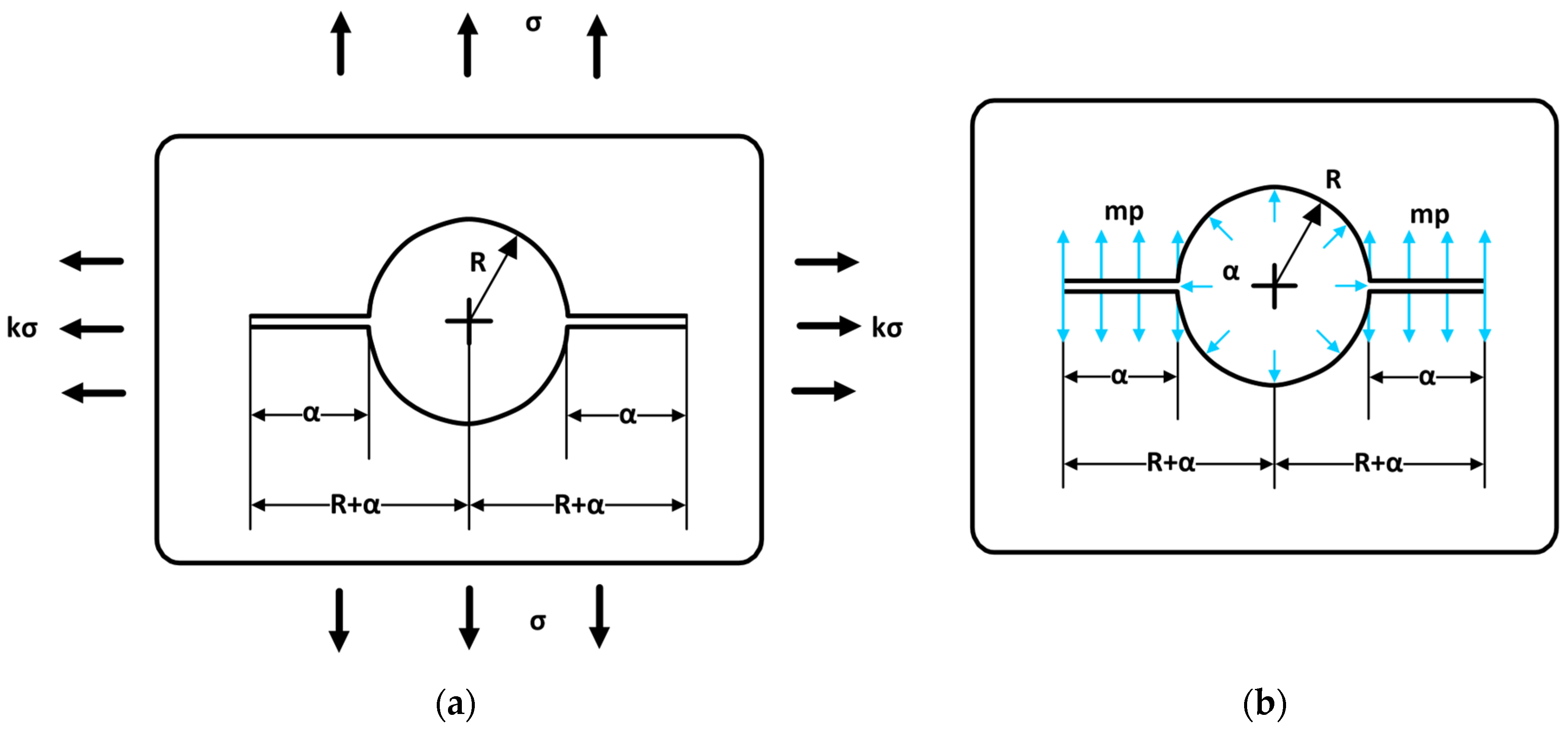
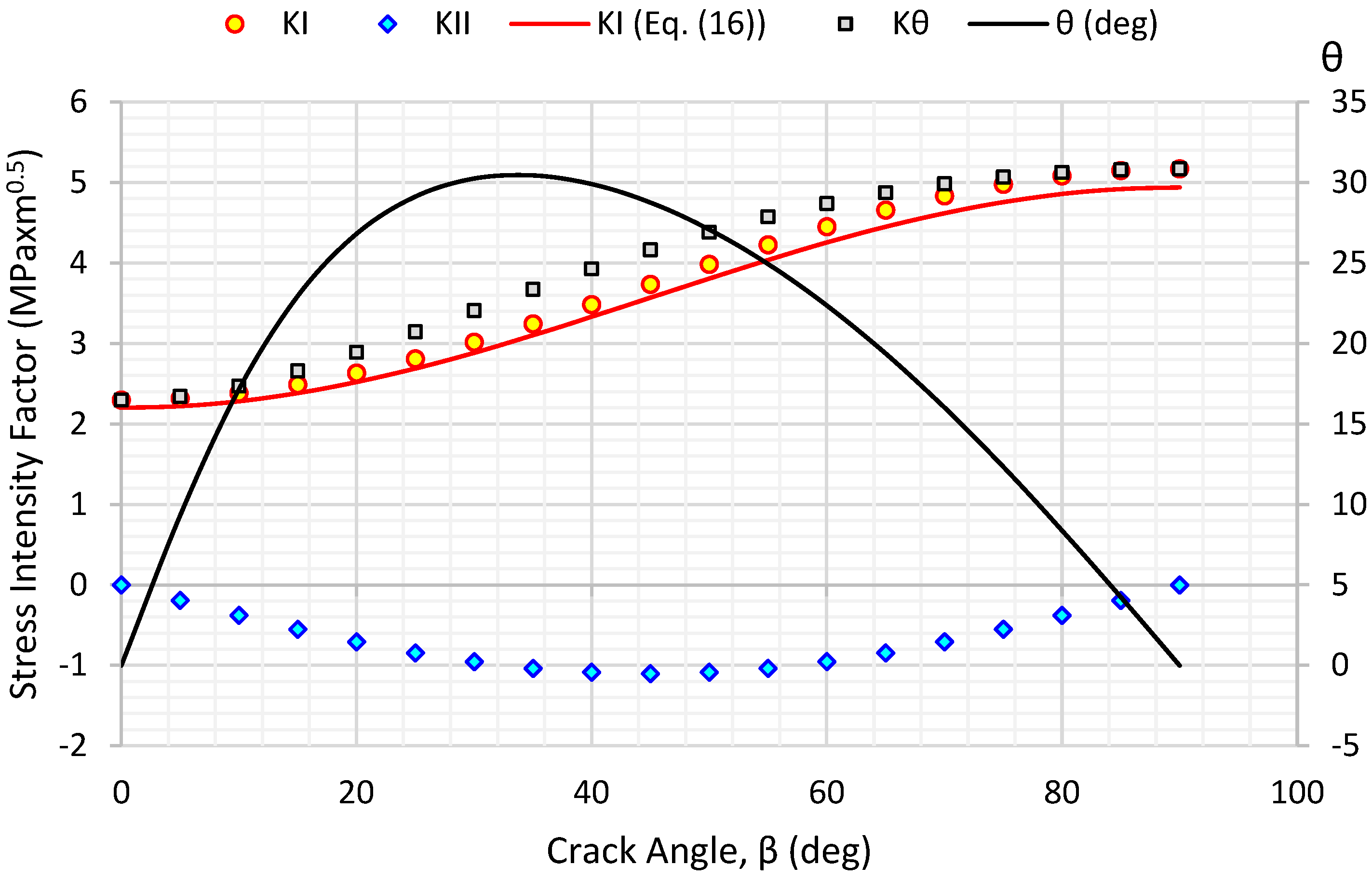
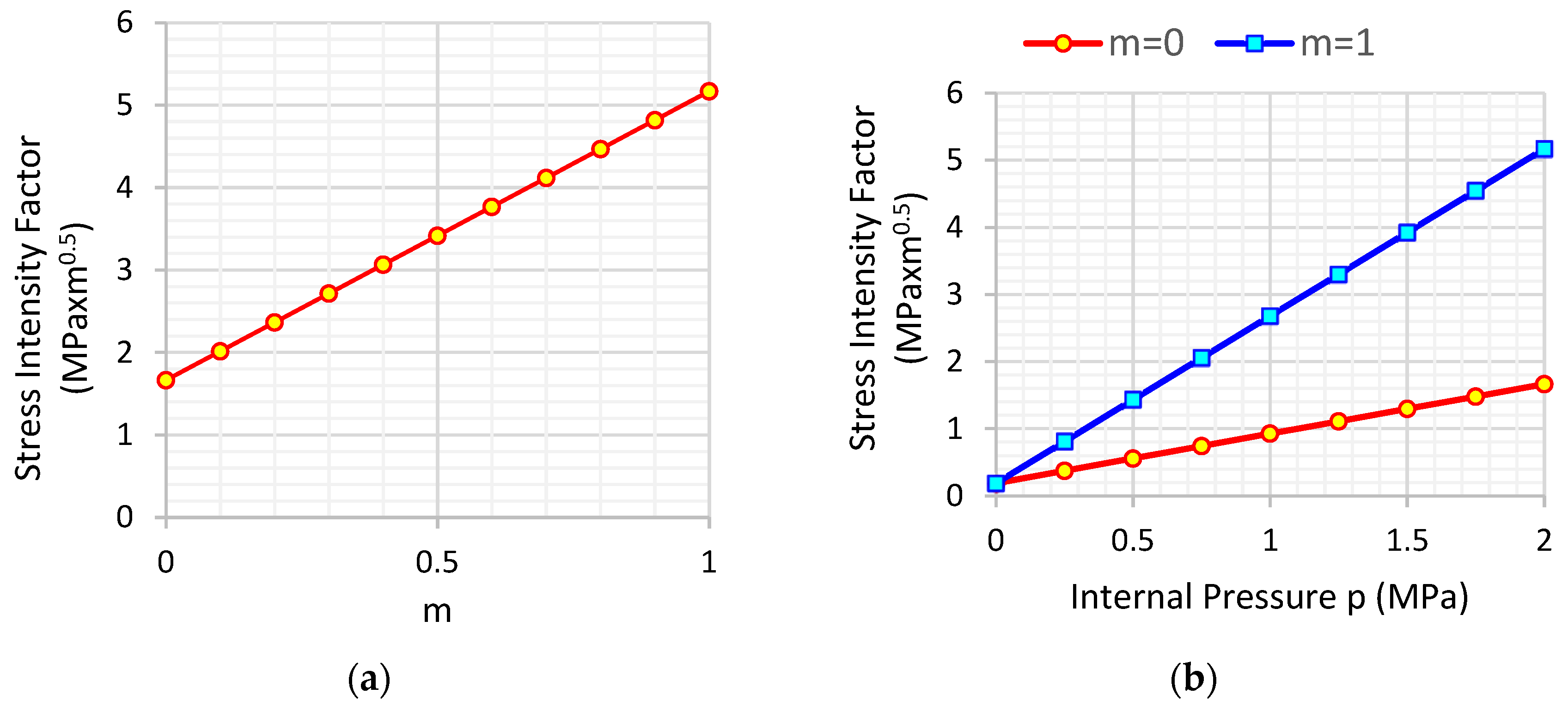
| Parameter | Symbol | Value | Unit |
|---|---|---|---|
| Young modulus | E | 20 | GPa |
| Poisson ratio | v | 0.3 | - |
| Shear stiffness | Ks | 100 | MPa/m |
| Normal stiffness | Kn | 100 | MPa/m |
Disclaimer/Publisher’s Note: The statements, opinions and data contained in all publications are solely those of the individual author(s) and contributor(s) and not of MDPI and/or the editor(s). MDPI and/or the editor(s) disclaim responsibility for any injury to people or property resulting from any ideas, methods, instructions or products referred to in the content. |
© 2023 by the authors. Licensee MDPI, Basel, Switzerland. This article is an open access article distributed under the terms and conditions of the Creative Commons Attribution (CC BY) license (https://creativecommons.org/licenses/by/4.0/).
Share and Cite
Xiroudakis, G.; Saratsis, G.; Lazos, I. Implementation of the Displacement Discontinuity Method in Geotechnical Case Studies. Geosciences 2023, 13, 272. https://doi.org/10.3390/geosciences13090272
Xiroudakis G, Saratsis G, Lazos I. Implementation of the Displacement Discontinuity Method in Geotechnical Case Studies. Geosciences. 2023; 13(9):272. https://doi.org/10.3390/geosciences13090272
Chicago/Turabian StyleXiroudakis, George, George Saratsis, and Ilias Lazos. 2023. "Implementation of the Displacement Discontinuity Method in Geotechnical Case Studies" Geosciences 13, no. 9: 272. https://doi.org/10.3390/geosciences13090272
APA StyleXiroudakis, G., Saratsis, G., & Lazos, I. (2023). Implementation of the Displacement Discontinuity Method in Geotechnical Case Studies. Geosciences, 13(9), 272. https://doi.org/10.3390/geosciences13090272









